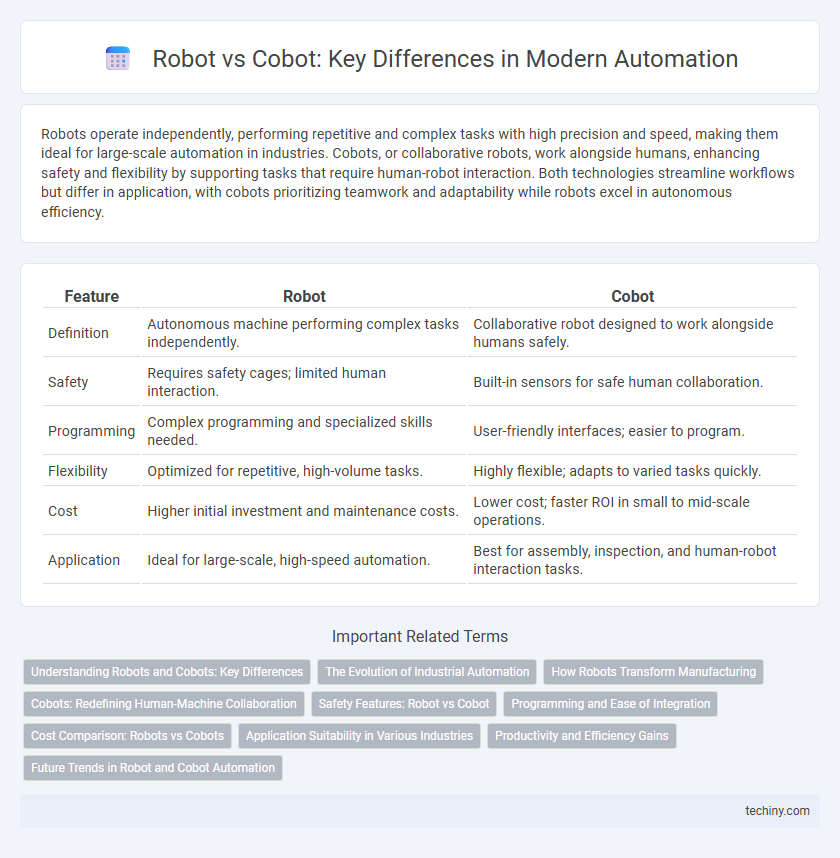Robots operate independently, performing repetitive and complex tasks with high precision and speed, making them ideal for large-scale automation in industries. Cobots, or collaborative robots, work alongside humans, enhancing safety and flexibility by supporting tasks that require human-robot interaction. Both technologies streamline workflows but differ in application, with cobots prioritizing teamwork and adaptability while robots excel in autonomous efficiency.
Table of Comparison
| Feature | Robot | Cobot |
|---|---|---|
| Definition | Autonomous machine performing complex tasks independently. | Collaborative robot designed to work alongside humans safely. |
| Safety | Requires safety cages; limited human interaction. | Built-in sensors for safe human collaboration. |
| Programming | Complex programming and specialized skills needed. | User-friendly interfaces; easier to program. |
| Flexibility | Optimized for repetitive, high-volume tasks. | Highly flexible; adapts to varied tasks quickly. |
| Cost | Higher initial investment and maintenance costs. | Lower cost; faster ROI in small to mid-scale operations. |
| Application | Ideal for large-scale, high-speed automation. | Best for assembly, inspection, and human-robot interaction tasks. |
Understanding Robots and Cobots: Key Differences
Robots are fully autonomous machines designed to perform complex, repetitive tasks in industrial environments without human intervention, offering high precision and speed. Cobots, or collaborative robots, operate alongside human workers, emphasizing safety features and ease of programming for shared tasks that require flexibility and close cooperation. Understanding the operational scope, integration capabilities, and safety standards distinguishes robots from cobots in automation applications.
The Evolution of Industrial Automation
Industrial automation has evolved from traditional robots performing repetitive, pre-programmed tasks in isolated environments to collaborative robots (cobots) designed to work safely alongside human operators. Cobots integrate advanced sensors, machine learning algorithms, and adaptive controls, enhancing flexibility and efficiency on manufacturing lines. This shift drives increased productivity, reduced operational risks, and enables personalized automation solutions tailored to dynamic production needs.
How Robots Transform Manufacturing
Industrial robots automate repetitive and precise tasks, significantly increasing manufacturing efficiency and consistency. Collaborative robots (cobots) work alongside human operators, enhancing flexibility and safety while optimizing complex workflows. The integration of robots and cobots accelerates production cycles and reduces operational costs, driving innovation in smart manufacturing environments.
Cobots: Redefining Human-Machine Collaboration
Cobots, or collaborative robots, are revolutionizing automation by working safely alongside humans without extensive safety barriers, enhancing productivity and flexibility. Unlike traditional robots that operate in isolation, cobots leverage advanced sensors and AI to adapt to human movements and tasks in real-time. This seamless integration reduces operational downtime while improving precision and ergonomics in manufacturing environments.
Safety Features: Robot vs Cobot
Industrial robots often require safety barriers and fencing to operate securely due to their high-speed, high-force capabilities, whereas cobots are designed with advanced safety features like force-limited joints and real-time sensors enabling safe human-robot collaboration without extensive guarding. Cobots use compliant control systems and sophisticated vision technologies to detect human presence, reducing collision risks and ensuring operator safety. The integration of emergency stop functions and speed/force monitoring in cobots provides enhanced safety compared to traditional robots, facilitating their deployment in shared workspaces.
Programming and Ease of Integration
Robots typically require complex programming languages and specialized expertise, making integration into existing workflows more time-consuming and costly. Cobots feature user-friendly interfaces and often support drag-and-drop programming or intuitive teach pendants, facilitating rapid deployment with minimal coding knowledge. Their seamless integration with human operators and existing systems reduces downtime and accelerates return on investment in automated processes.
Cost Comparison: Robots vs Cobots
Cobots generally offer a lower upfront cost compared to traditional industrial robots, making them more accessible for small to medium-sized enterprises. While robots require expensive safety measures, programming, and infrastructure, cobots are designed for easier integration and collaborative work alongside humans, reducing installation and operational expenses. Long-term costs also favor cobots due to their flexibility, quicker deployment, and reduced need for specialized operators or complex maintenance.
Application Suitability in Various Industries
Robots excel in high-volume manufacturing environments such as automotive and electronics, where precision and speed are crucial, handling repetitive tasks with minimal human intervention. Cobots, or collaborative robots, are ideal for industries like healthcare, logistics, and small-scale assembly, where human-robot interaction enhances flexibility and safety. The suitability depends on task complexity, workspace constraints, and the need for adaptability within dynamic industrial processes.
Productivity and Efficiency Gains
Robots deliver high productivity through autonomous, repetitive tasks in controlled environments, minimizing errors and increasing throughput in large-scale manufacturing. Cobots enhance efficiency by collaborating directly with human workers, offering flexibility and adaptability in dynamic workspaces, thereby optimizing workflow and reducing downtime. Integrating both robots and cobots strategically maximizes productivity and operational efficiency across diverse industrial applications.
Future Trends in Robot and Cobot Automation
Robot and cobot automation is rapidly evolving with advancements in artificial intelligence and machine learning, enabling enhanced adaptability and precision in diverse industrial applications. Collaborative robots (cobots) are expected to gain greater integration in small and medium-sized enterprises due to their safety features and ease of programming, fostering human-robot collaboration on production lines. The future of automation emphasizes seamless interaction between autonomous robots and cobots, driving efficiency, flexibility, and scalability in manufacturing and logistics sectors.
Robot vs Cobot Infographic

 techiny.com
techiny.com